090815_YKMV_A16.pdf
September 8, 2015 • Page 16
shop online at www.missourivalleyshopper.com
ll home improvement
Fa
& car care
How to stay within your home improvement budget
Homeowners willing and able to pitch in on their home projects can save themselves
a substantial amount of money on labor costs.
Home improvement
projects range from small
scale undertakings that
can be tackled in a single
weekend to large remodels
that can take several months
to complete. While no two
projects are the same, every
home improvement project
demands that homeowners
dip into their pockets and
spend some money.
Much like the scale of
projects varies greatly, so,
too, do the financial commitments required of homeowners to make those projects
a reality. But no matter the
size of the project, homeowners can find ways to
stretch their budgets without sacrificing the quality of
their improvements.
* Do your homework.
Before you decide to make
changes to your home,
it’s best to first do some
research into any potential
projects you’re considering. Many homeowners
have decided to dive into
a project before they fully
realize its scope and cost,
and going in blind can bust a
budget, turning what might
have seemed like a relatively
simple project into a money
pit.
Understanding just what
a project entails and how
much it’s likely to cost can
give homeowners an idea
of what they can afford and
where they might be able to
stretch their budgets. For example, if you want to replace
your kitchen countertops
but can’t afford engineered
quartz countertops, you
might be able to find a less
expensive alternative, such
as tile, that you like just
as much. But it’s best to
research such alternatives
before you decide to replace
your existing countertops. If
you can’t find a less expensive alternative, you might
want to postpone the project
until you can grow your budget. But starting the project
without first grasping its true
cost is a recipe for disaster,
so do your homework before
you find your toolbox and
start working.
* Build unforeseen
expenses into your budget.
Another way to stay within
your budget is to include
budget-busting unforeseen
expenses into the budget
from the get-go. Whether
you’re doing the project
yourself or paying a contractor, nearly every home
improvement project will
present some unforeseen,
and costly, hurdles. For example, you might find mold
inside the walls when you’re
converting a basement, and
it can cost a pretty penny
to make that mold go away.
If you go into the project
expecting such hurdles,
then the financial sting of
addressing them won’t prove
too great a burden. But if
the mold catches you and
your budget completely off
guard, you might be forced
to overextend that budget or
make sacrifices elsewhere in
order to complete the project. Build some contingency
money, including permit
and permit fees, into your
home improvement project
to safeguard against such
unforeseen issues.
* Get to work. If you’re
hiring a contractor, speak
to him or her before signing
a contract to see if there is
anywhere you can pitch in
to keep the labor costs low.
You might be able to pitch in
during the demolition phase,
saving the cost of paying
your contractor’s workers to
tear down walls or remove
debris you can just as easily
remove yourself. Another
way to pitch in is to do the
end-of-day cleanup yourself.
Any role you play with regard to labor will likely need
to be negotiated upfront,
but you can save yourself a
substantial amount of money
on labor if you’re willing to
get your hands dirty.
* Determine if piecemeal
is the most affordable option. Sometimes it makes
sense to tackle one project
at a time, while other times
you might want to combine
projects to save on the cost
of materials. For instance, if
your ultimate goal is to install wood flooring throughout your home, determine
if it makes more financial
sense to install the flooring
all at once rather than doing
one or two rooms at a time.
You might save by buying
all of your materials at once
rather than buying a small
amount of materials several
times over the next several
years.
Home improvement
projects often go a long way
toward making a home more
enjoyable for its owners and
inhabitants. And while such
projects can be costly, homeowners who stay disciplined
can still get their dream
homes without busting their
budgets.
Car battery care in extreme weather
Few things can be more
frustrating than jumping into
the driver’s seat on a frosty
morning, turning the key in
the ignition and failing to
hear the engine roar to life.
Frigid weather can cause
trouble with a car’s battery.
Some drivers do not understand why, but getting the
facts can help people avoid
having to deal with dead batteries on cold winter days.
Cold temperatures wreak
havoc on batteries because
they slow the chemical reaction inside of the battery.
Batteries work by combining
lead plates with lead dioxide
and sulfuric acid to create
electrons. While batteries
can function under myriad
conditions, the cold weather
tends to degrade high-quality batteries and may render
subpar batteries useless.
The cold weather can cause
the fluid in the battery to
freeze and lose function. A
battery that is frozen will
not hold a charge, and, as a
result, the car won’t start.
There are various ways
to protect a battery from
failure in the cold, and some
of them involve taking precautionary measures even
before the arrival of cold
weather.
* Assess the age of your
battery. If your battery is
old, now may be the time to
replace it. Batteries differ
in how long they last, but
many last anywhere from
five to 10 years. If your car
is still running on its original
battery and your card is
several years old, it may
be a good idea to get a new
battery before the arrival of
winter. Battery size will not
necessarily provide better
starting. It’s important to
buy the correct battery for
the make of your car, which
can usually be found inside
of the owner’s manual.
* Verify that there is no
corrosion. Corrosion can
prevent a car from starting
just as much as a worn-out
battery. Corrosion is caused
by a faulty connection that
allows battery acid to escape and corrode surround-
Drivers should replace old car batteries before the arrival of winter weather.
ing areas. Regularly inspect
the battery to keep abreast
of issues that may cause
corrosion. Carefully clean
away any corrosive residue
that has formed and make
Get Your Car Ready for Back-To-School!
JR’s Auto Repair
Located: From Hartington 4 miles West
on Hwy 84 and 2 miles South
88005 559 Ave.
Hartington, NE 68739
402-254-9235
Serving You With All
Your Auto Repair Needs!
Lowest Labor Rates In The Area!
Mon-Fri 7:30am-6pm • Sat 8am-2pm
We’re more than
just Auto Parts!
1509 E. Hwy 50 • Yankton, SD
605-665-3693 • 800-658-3388
www.sturdevants.com
sure the battery is correctly
seated.
* Install a battery blanket.
A battery blanket is used
to wrap around the battery
and fit inside of the battery
cover. A cord with a plug
runs from the blanket to a
wall outlet. The blanket can
produce enough heat to
keep the battery fluid from
freezing. A trickle charger
can also be mounted on
the battery. It will deliver
enough power to the battery
while the car is off to keep it
from freezing.
* Minimize the use of automotive accessories. Do not
Christensen’s
Radiator & Repair
Make your spa
a part of your
daily personal
wellness program!
Stop in to see our wide variety
of Hot Tubs available for
every size & budget!
LEISURE WORLD, INC.
Spas • Swimming Pools • Saunas
1900 Broadway Ave, Yankton, SD • 605-665-1240
2500 S. 13th St., Norfolk, NE • 402-371-8425
w w w.leisureworldsd.com
Tune Ups • Brakes • Cooling Systems
Trailer Hitches & Accessories
start the car with the heater
and the radio on. They can
use up the power coming
from the car’s alternator and
prevent the battery from
charging. Do not leave the
heat and the radio on while
the car is idling. Otherwise
the car will not be putting
out enough power for the
alternator to charge the battery and power the electrical
systems.
* Disconnect the battery.
If your car will be stored in a
garage for the winter, disconnect the battery. Certain
devices, such as clocks and
alarm systems, continue to
drain battery power when
the vehicle is off. If your car
will not be driven enough to
recharge the battery, keep it
disconnected when the automobile is being stored.
Cold weather can
sometimes wreak havoc on
vehicles. Knowing how to
skirt trouble with your car’s
battery can keep your car
on the road throughout the
winter.
finding the right
job is easier
than you think
General repair & diagnostics
Dan & Dean Christensen
1918 Locust • Yankton
665-3549
HVAC & Electrical Contractors
Power Source
Electric
Your Heating & Cooling
Specialists
665.2895
Residential & Commercial
Electrical Contractors
260.8683
Divisions of Electair, Inc.
Chris Frick
Doug Dykstra
when you’ve
got the right
direction
Stop searching. The
Help Wanted section
of the Missouri Valley
Shopper list many
possible new job
opportunities.
Find a career that’s
right for you.
MV Shopper
M I S S O U R I VA L L E Y
M I S S O U R I VA L L E Y










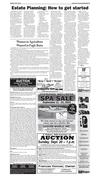


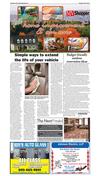


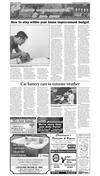
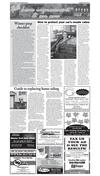






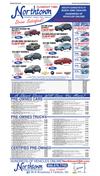
 Previous Page
Previous Page




